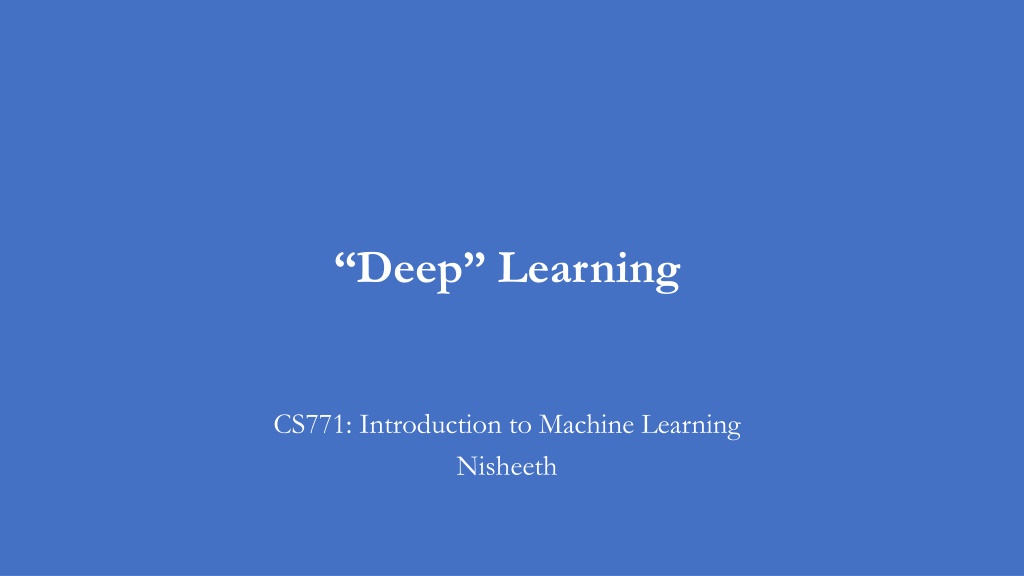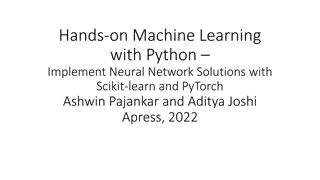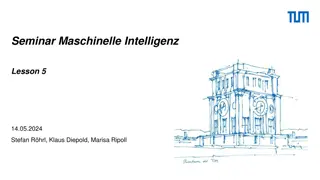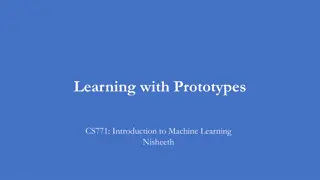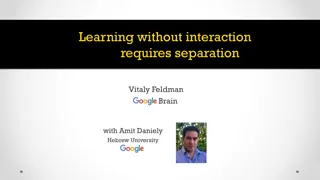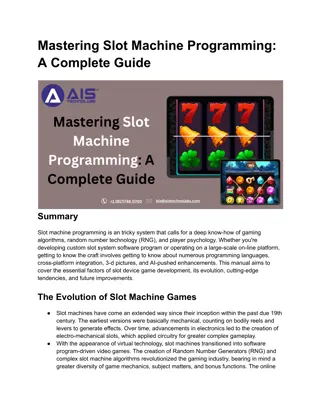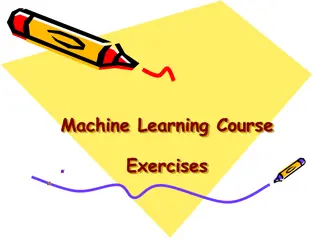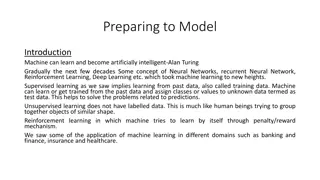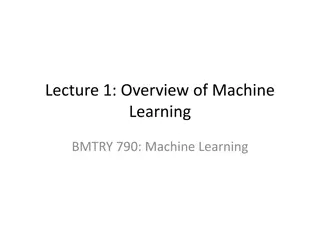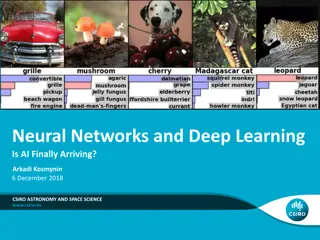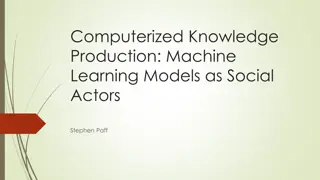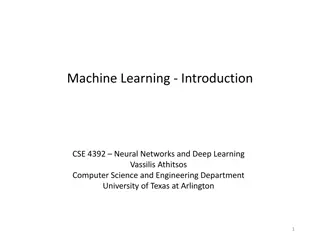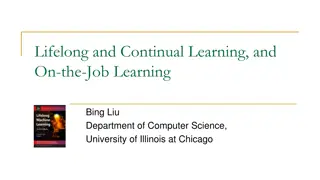Exploring Limitations and Advancements in Machine Learning
Unveil the limitations of linear and classic non-linear models in machine learning, showcasing the emergence of neural networks like Multi-layer Perceptrons (MLPs) as powerful tools to tackle non-linear functions and decision boundaries efficiently. Discover the essence of neural networks and their transformative impact in handling complex datasets through multiple hidden layers and nonlinear activations.
Download Presentation

Please find below an Image/Link to download the presentation.
The content on the website is provided AS IS for your information and personal use only. It may not be sold, licensed, or shared on other websites without obtaining consent from the author. Download presentation by click this link. If you encounter any issues during the download, it is possible that the publisher has removed the file from their server.
E N D
Presentation Transcript
Deep Learning CS771: Introduction to Machine Learning Nisheeth
2 Limitations of Linear Models Linear models: Output produced by taking a linear combination of input features Some monotonic function (e.g., sigmoid) This basic architecture is classically also known as the Perceptron (not to be confused with the Perceptron algorithm , which learns a linear classification model) This can t however learn nonlinear functions or nonlinear decision boundaries CS771: Intro to ML
3 Limitations of Classic Non-Linear Models Non-linear models: kNN, kernel methods, generative classification, decision trees etc. All have their own disadvantages kNN and kernel methods are expensive to generate predictions from Kernel based and generative models particularize the decision boundary to a particular class of functions, e.g. quadratic polynomials, gaussian functions etc. Decision trees require optimization over many arbitrary hyperparameters to generate good results, and are (somewhat) expensive to generate predictions from Not a deal-breaker, most common competitor for deep learning over large datasets tends to be some decision-tree derivative In general, non-linear ML models are complicated beasts CS771: Intro to ML
4 Neural Networks: Multi-layer Perceptron (MLP) An MLP consists of an input layer, an output layer, and one or more hidden layers Output Layer (with a scalar-valued output) Learnable weights Hidden layer units/nodes act as new features Hidden Layer (with K=2 hidden units) Can think of this model as a combination of two predictions ?1and ?2 of two simpler models Input Layer (with D=3 visible units) CS771: Intro to ML
5 Illustration: Neural Net with One Hidden Layer Each input ?? transformed into several pre- activations using linear models Can even be identity (e.g., for regression yn = sn ) Nonlinear activation applied on each pre-act. Linear model learned on the new features ?? Finally, output is produced as ? = ?(??) Unknowns (?1,?2, ,??,?) learned by minimizing some loss function, for example ?,? = ?=1 (??,?(??)) (squared, logistic, softmax, etc) ? CS771: Intro to ML
Will denote a linear combination of inputs followed by a nonlinear operation on the result 6 Neural Nets: A Compact Illustration Note: Hidden layer pre-act ??? and post-act ?? will be shown together for brevity Will directly show the final output Will combine pre-act and post-act and directly show only ??to denote the value computed by a hidden node Single Hidden Layer More succinctly.. Different layers may use different non-linear activations. Output layer may have none. CS771: Intro to ML
7 Activation Functions: Some Common Choices tanh sigmoid Preferred more than sigmoid. Helps keep the mean of the next layer s inputs close to zero (with sigmoid, it is close to 0.5) For sigmoid as well as tanh, gradients saturate (become close to zero as the function tends to its extreme values) h h a a Leaky ReLU ReLU ReLU and Leaky ReLU are among the most popular ones Helps fix the dead neuron problem of ReLU when ? is a negative number h a CS771: Intro to ML
8 MLP Can Learn Nonlin. Fn: A Brief Justification An MLP can be seen as a composition of multiple linear models combined nonlinearly High-score in the middle and low- score on either of the two sides of it. Exactly what we want for the given classification problem Obtained by composing the two one- sided increasing score functions (using ?1 = 1, and ?2 = -1 to flip the second one before adding). This can now learn nonlinear decision boundary score Score monotonically increases. One-sided increase (not ideal for learning nonlinear decision boundaries) score score score A nonlinear classification problem Standard Single Perceptron Classifier (no hidden units) A single hidden layer MLP with sufficiently large number of hidden units can approximate any function (Hornik, 1991) A Multi-layer Perceptron Classifier (one hidden layer with 2 units) Capable of learning nonlinear boundaries CS771: Intro to ML
9 Examples of some basic NN/MLP architectures CS771: Intro to ML
10 Single Hidden Layer and Single Outputs One hidden layer with ? nodes and a single output (e.g., scalar-valued regression or binary classification) CS771: Intro to ML
11 Single Hidden Layer and Multiple Outputs One hidden layer with ? nodes and a vector of ? output (e.g., vector-valued regression or multi-class classification or multi-label classification) CS771: Intro to ML
12 Multiple Hidden Layers (One/Multiple Outputs) Most general case: Multiple hidden layers with (with same or different number of hidden nodes in each) and a scalar or vector-valued output CS771: Intro to ML
13 Neural Nets are Feature Learners Hidden layers can be seen as learning a feature rep. ? ?? for each input ?? The last hidden layer s values CS771: Intro to ML
14 Kernel Methods vs Neural Nets Recall the prediction rule for a kernel method (e.g., kernel SVM) This is analogous to a single hidden layer NN with fixed/pre-defined hidden nodes ? ??,? ?=1 and output weights ?? ?=1 The prediction rule for a deep neural network ? ? Also note that neural nets are faster than kernel methods at test time since kernel methods need to store the training examples at test time whereas neural nets do not Here, the ? s are learned from data (possibly after multiple layers of nonlinear transformations) Both kernel methods and deep NNs be seen as using nonlinear basis functions for making predictions. Kernel methods use fixed basis functions (defined by the kernel) whereas NN learns the basis functions adaptively from data CS771: Intro to ML
15 Feature Learned by a Neural Network Node values in each hidden layer tell us how much a learned feature is active in ?? Hidden layer weights are like pattern/feature-detector/filter All the incoming weights (a vector) on this hidden node can be seen as representing a pattern/feature-detector/filter (2) denotes a ?1-dim Here, ?32 template/pattern/feature-detector All the incoming weights (a vector) on this hidden node can be seen as representing a template/pattern/feature-detector (1) denotes a D-dim Here, ?100 pattern/feature-detector/filter CS771: Intro to ML
16 Why Neural Networks Work Better: Another View Linear models tend to only learn the average pattern Deep models can learn multiple patterns (each hidden node can learn one pattern) Thus deep models can learn to capture more subtle variations that a simpler linear model CS771: Intro to ML
